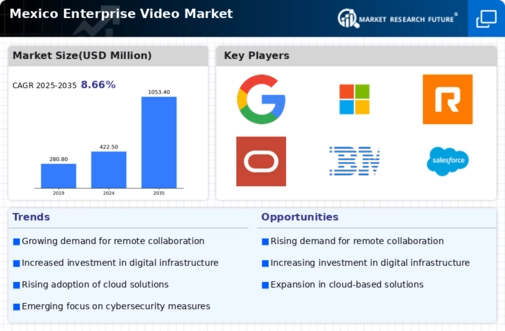The enterprise video market in Mexico is characterized by a dynamic competitive landscape, driven by increasing demand for digital communication solutions and enhanced collaboration tools. Major players such as Microsoft (US), Cisco (US), and Zoom (US) are strategically positioned to leverage their technological advancements and extensive service offerings. Microsoft (US) focuses on integrating its video solutions with its broader suite of productivity tools, thereby enhancing user experience and fostering customer loyalty. Cisco (US), on the other hand, emphasizes security and reliability in its video conferencing solutions, appealing to enterprises with stringent compliance requirements. Zoom (US) continues to innovate with features that enhance user engagement, positioning itself as a leader in user-friendly video solutions. Collectively, these strategies contribute to a competitive environment that is increasingly centered around innovation and customer-centric solutions.
Key business tactics within the enterprise video market include localizing services and optimizing supply chains to better meet regional demands. The market structure appears moderately fragmented, with several key players holding substantial market shares while also facing competition from emerging startups. This fragmentation allows for diverse offerings, yet the influence of established companies remains significant, as they set industry standards and drive technological advancements.
In October 2025, Microsoft (US) announced the launch of a new AI-driven feature within its Teams platform, aimed at enhancing real-time translation capabilities. This strategic move is likely to broaden its appeal in multilingual environments, thereby increasing its market penetration in diverse sectors. The integration of AI not only enhances user experience but also positions Microsoft (US) as a forward-thinking leader in the enterprise video space, potentially attracting new clients seeking advanced communication tools.
In September 2025, Cisco (US) unveiled a partnership with a leading cybersecurity firm to bolster the security features of its Webex platform. This collaboration underscores Cisco's commitment to providing secure video conferencing solutions, which is increasingly critical in a landscape where data breaches are prevalent. By enhancing security measures, Cisco (US) not only protects its existing customer base but also attracts enterprises that prioritize data security, thereby strengthening its competitive position.
In August 2025, Zoom (US) expanded its global footprint by entering into a strategic alliance with a prominent telecommunications provider in Mexico. This partnership aims to enhance connectivity and service delivery for local businesses, indicating Zoom's intent to deepen its market presence. Such alliances are crucial for expanding reach and improving service quality, which may lead to increased customer satisfaction and retention.
As of November 2025, current trends in the enterprise video market include a pronounced shift towards digitalization, sustainability, and the integration of AI technologies. Strategic alliances are increasingly shaping the competitive landscape, enabling companies to pool resources and expertise. Looking ahead, competitive differentiation is likely to evolve from traditional price-based competition to a focus on innovation, technological advancements, and supply chain reliability. This shift suggests that companies that prioritize these areas will be better positioned to thrive in an increasingly competitive environment.

















Leave a Comment